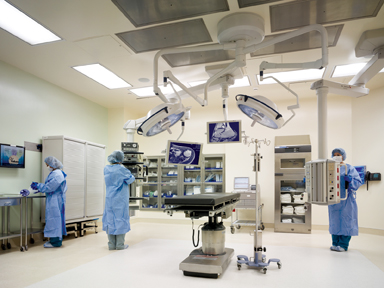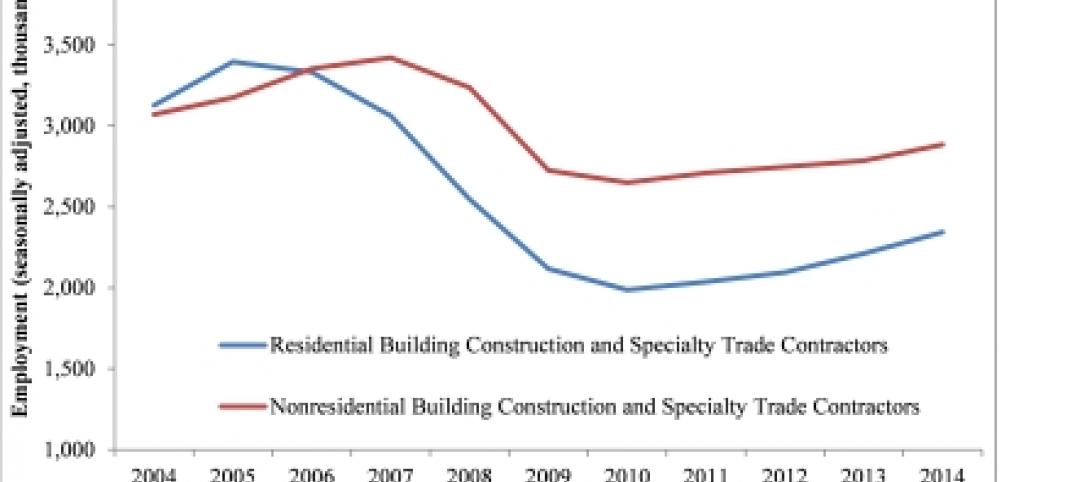The healthcare sector faces grave financial uncertainties, even with the June 28 Supreme Court decision upholding the Affordable Care Act. To help us sort out the factors impacting this lucrative segment, we turned to Philip Tobey, a Fellow of both the AIA and the American College of Healthcare Architects and Senior Vice President with SmithGroupJJR.
“Health industry providers legitimately expect significant efficiencies and lower costs for design and construction services, to go along with the economies that they themselves face with tighter and value-based reimbursement terms under health reform,” says Tobey, a member of Building Design+Construction’s Editorial Board.
In other words, AEC firms are going to have to share some of their healthcare clients’ pain. The drive for greater operational efficiency and lower cost in healthcare will be unrelenting, with bundled payments and shared savings models in lieu of traditional fee-for-service reimbursement forcing healthcare providers to eliminate wasteful practices.
Tobey sees three major trends emerging: 1) growing emphasis on ambulatory care, 2) medical systems integration, and 3) the “bundling/unbundling” of services.
SCROLL DOWN FOR GIANTS 300 TOP 25 AEC HEALTHCARE FIRM RANKINGS
1. PUSHING AMBULATORY CARE FACILITIES OUT
“The trend to push services out of the hospital into ambulatory settings will only intensify,” says Tobey. He notes, however, that there will be an “overwhelming need” to expand the front end of delivery—primary care, urgent care, and emergency departments—and to rationalize procedural and imaging resource capacity. At the same time, freestanding surgery and imaging centers may not be as prevalent in the future, and may need to be consolidated into larger hospital centers.
“Hospitals are not going away,” says Tobey, even though inpatient volumes are predicted to fall 5%, vs. 30% growth in outpatient volume. The sheer increased volume of patients, especially as baby boomers age, will inevitably drive up acute-care admissions. In the face of these seemingly countervailing trends, says Tobey, “The need to renovate outdated or obsolete facilities will be a strong driver in the healthcare business.”
2. INTEGRATING MEDICAL SYSTEMS MORE TIGHTLY
Tobey says the need for greater efficiency and ever-higher quality of care are not new goals for medical care or medical design, but hospital systems are being encouraged further by healthcare reform to streamline processes, with more mergers, acquisitions, and hospital-physician staff integrations on the horizon. “The industry’s even been talking about including services like long-term care and home care into this integrated approach,” he says.
Although there will always be a need for acute-care hospitals, Tobey sees a possible shift toward more community-based portals. As health systems continue to integrate, they will rely more and more on treatment venues outside the hospital to provide patients with coordinated preventive care and treatment for chronic conditions.
The IT component of hospital systems is already a natural for systems integration. “Providing the right information where it’s needed is essential for clinical care,” says Tobey, who foresees greater implementation of electronic medical records.
Are hospitals ready for lean?
“Everybody’s talking about it, but many hospital owners are wary of taking on lean,” says SmithGroupJJR’s Phil Tobey, FAIA, FACHA, whose firm is on the team for Sutter Health’s California Pacific Medical Center in San Francisco, the largest lean project in the U.S. “You have Sutter, which is totally lean, then you have clients who tell us not even to mention the word,” he says. “Others are applying the basic principles of lean construction without carrying the heavy weight of all that lean entails.”
Applying Lean/Six Sigma principles to healthcare, says Jeffrey C. Stouffer, AIA, a Principal with HKS, would result in “measurable outcomes and even risk sharing as part of the design and construction process” by eliminating unnecessary waste in construction and operations and increasing staff efficiency and safety, while reducing energy and staff costs for the hospital.
3. UNBUNDLING/BUNDLING OF HEALTHCARE SERVICES
Healthcare providers are “decanting” non-core functions—services like pharmacy, lab support, materials handling, and environmental management—from the mother ship into cheaper B-occupancy buildings. “Anything soft, anything that’s not high-tech, is being taken out,” says Tobey. “That’s the unbundling.”
However, once the unbundling of less-intense services has been accomplished, says Tobey, some hospital systems are opting to bundle the remaining hospital space, by placing beds back on top of the structure’s base diagnostic and support block, instead of having the traditional diagnostic/support chassis with attached nursing wings.
“You unbundle and decant the support services, then take the remaining high-intensity hospital base and put the beds on top,” says Tobey. A recent study for a 100-bed community hospital found that following such a scheme would result in 39% savings in construction costs per bed. +
TOP 25 HEALTHCARE SECTOR ARCHITECTURE FIRMS
| Rank | Company | 2011 Healthcare Revenue ($) |
| 1 | HDR Architecture | 205,200,000 |
| 2 | HKS | 124,736,964 |
| 3 | Perkins+Will | 122,895,589 |
| 4 | Cannon Design | 121,000,000 |
| 5 | NBBJ | 116,401,000 |
| 6 | HOK | 102,695,248 |
| 7 | SmithGroupJJR | 74,600,000 |
| 8 | RTKL Associates | 68,421,405 |
| 9 | Perkins Eastman | 63,700,000 |
| 10 | Hammel, Green and Abrahamson | 61,900,000 |
| 11 | ZGF Architects | 54,338,355 |
| 12 | Heery International | 48,583,000 |
| 13 | HMC Architects | 42,715,899 |
| 14 | PageSoutherlandPage | 38,670,000 |
| 15 | IBI Group | 37,349,554 |
| 16 | Skidmore, Owings & Merrill | 33,950,000 |
| 17 | FKP Architects | 33,947,200 |
| 18 | Gresham, Smith and Partners | 32,876,981 |
| 19 | FreemanWhite | 28,500,000 |
| 20 | RBB Architects | 28,500,000 |
| 21 | LEO A DALY | 26,900,325 |
| 22 | BSA LifeStructures | 26,323,759 |
| 23 | EwingCole | 24,000,000 |
| 24 | KMD Architects | 20,161,678 |
| 25 | Ennead Architects | 19,875,000 |
TOP 25 HEALTHCARE SECTOR ENGINEERING FIRMS
| Rank | Company | 2011 Healthcare Revenue ($) |
| 1 | AECOM Technology Corp. | 314,000,000 |
| 2 | Stantec | 109,980,000 |
| 3 | URS Corp. | 41,298,918 |
| 4 | Smith Seckman Reid | 38,300,000 |
| 5 | Jacobs | 32,950,000 |
| 6 | Parsons Brinckerhoff | 30,600,000 |
| 7 | KPFF Consulting Engineers | 28,000,000 |
| 8 | TTG|TMAD TAYLOR & GAINES | 27,677,900 |
| 9 | Mazzetti Nash Lipsey Burch | 24,988,296 |
| 10 | Degenkolb Engineers | 22,454,591 |
| 11 | Allen & Shariff | 21,577,769 |
| 12 | Bard, Rao + Athanas Consulting Engineers | 18,000,000 |
| 13 | ccrd partners | 17,100,000 |
| 14 | Atkins North America | 16,173,240 |
| 15 | AKF Group | 15,200,000 |
| 16 | KJWW Engineering Consultants | 14,607,369 |
| 17 | Syska Hennessy Group | 14,462,238 |
| 18 | Zak Companies | 13,882,705 |
| 19 | TLC Engineering for Architecture | 13,874,283 |
| 20 | Dewberry | 10,613,564 |
| 21 | Thornton Tomasetti | 9,860,000 |
| 22 | Sparling | 9,658,825 |
| 23 | Walter P Moore | 7,718,326 |
| 24 | M/E Engineering | 7,700,000 |
| 25 | Rutherford & Chekene | 7,650,000 |
TOP 25 HEALTHCARE SECTOR CONSTRUCTION FIRMS
| Rank | Company | 2011 Healthcare Revenue ($) |
| 1 | Turner Corporation, The | 1,807,050,000 |
| 2 | McCarthy Holdings | 1,231,000,000 |
| 3 | Gilbane Building Co. | 1,091,777,000 |
| 4 | Clark Group | 1,067,411,678 |
| 5 | PCL Construction Enterprises | 869,130,091 |
| 6 | Brasfield & Gorrie | 833,522,003 |
| 7 | Skanska USA | 724,418,042 |
| 8 | JE Dunn Construction | 636,206,095 |
| 9 | Robins & Morton | 599,073,000 |
| 10 | DPR Construction | 588,199,172 |
| 11 | Whiting-Turner Contracting Co., The | 464,779,240 |
| 12 | Mortenson | 455,620,000 |
| 13 | Lend Lease | 434,626,482 |
| 14 | Hensel Phelps Construction | 425,760,000 |
| 15 | Suffolk Construction | 420,343,563 |
| 16 | Pepper Construction Group | 415,064,000 |
| 17 | Tutor Perini Corp. | 409,583,000 |
| 18 | Balfour Beatty US | 389,253,907 |
| 19 | Hunt Construction Group | 369,500,000 |
| 20 | Hoar Construction | 313,937,000 |
| 21 | Flintco | 291,400,000 |
| 22 | Layton Construction | 287,300,000 |
| 23 | HBE Corp. | 279,200,000 |
| 24 | Power Construction | 275,000,000 |
| 25 | Swinerton | 274,627,440 |
Related Stories
| Jan 12, 2015
23 projects win AIA's highest architecture award
Bjarke Ingels' Danish Maritime Museum and William Rawn's Cambridge Public Library are among the winning projects.
| Jan 9, 2015
Santiago Calatrava talks with BBC about St. Nicholas Church on Ground Zero
Calatrava reveals that he wanted to retain the “tiny home” feel of the original church building that was destroyed with the twin towers on 9/11.
| Jan 9, 2015
Nonresidential construction hiring surges in December 2014
The U.S. construction industry added 48,000 jobs in December, including 22,800 jobs in nonresidential construction, according to the Bureau of Labor Statistics preliminary estimate released Jan. 9.
| Jan 9, 2015
10 surprising lessons Perkins+Will has learned about workplace projects
P+W's Janice Barnes shares some of most unexpected lessons from her firm's work on office design projects, including the importance of post-occupancy evaluations and having a cohesive transition strategy for workers.
| Jan 9, 2015
Technology and media tenants, not financial companies, fill up One World Trade Center
The financial sector has almost no presence in the new tower, with creative and media companies, such as magazine publisher Conde Nast, dominating the vast majority of leased space.
| Jan 8, 2015
Microsoft shutters classic clipart gallery: Reaction from a graphic designer
Microsoft shut down its tried-and-true clipart gallery, ridding the world not only of a trope of graphic design, but a nostalgic piece of digital design history, writes HDR's Dylan Coonrad.
| Jan 8, 2015
The future of alternative work spaces: open-access markets, co-working, and in-between spaces
During the past five years, people have begun to actively seek out third places not just to get a day’s work done, but to develop businesses of a new kind and establish themselves as part of a real-time conversation of diverse entrepreneurs, writes Gensler's Shawn Gehle.
Smart Buildings | Jan 7, 2015
NIBS report: Small commercial buildings offer huge energy efficiency retrofit opportunities
The report identifies several barriers to investment in such retrofits, such as the costs and complexity associated with relatively small loan sizes, and issues many small-building owners have in understanding and trusting predicted retrofit outcomes.
| Jan 7, 2015
University of Chicago releases proposed sites for Obama library bid
There are two proposed sites for the plan, both owned by the Chicago Park District in Chicago’s South Side, near the university’s campus in Hyde Park, according to the Chicago Sun-Times.
| Jan 7, 2015
4 audacious projects that could transform Houston
Converting the Astrodome to an urban farm and public park is one of the proposals on the table in Houston, according to news site Houston CultureMap.
















